Search Result
Results for "
MT-2
" in MedChemExpress (MCE) Product Catalog:
6
Isotope-Labeled Compounds
| Cat. No. |
Product Name |
Target |
Research Areas |
Chemical Structure |
-
- HY-101358
-
|
AH-002
|
Melatonin Receptor
|
Neurological Disease
|
|
8-M-PDOT (AH-002) is a selective melatonin MT2 receptor agonist. 8-M-PDOT is 5.2-fold selective for MT2 over MT1 receptors. 8-M-PDOT binds human recombinant MT2 and MT2 receptors with pKi values of 8.23 and 8.95 respectively. 8-M-PDOT has anxiolytic-like activity [2].
|
-

-
- HY-122136
-
|
|
Melatonin Receptor
|
Neurological Disease
|
|
S26131 (compound 5) is a potent and selective MT1 melatoninergic ligand, and the Ki values are 0.5 and 112 nM for MT1 and MT2, respectively. S26131 behaves as an MT1 and MT2 antagonist .
|
-
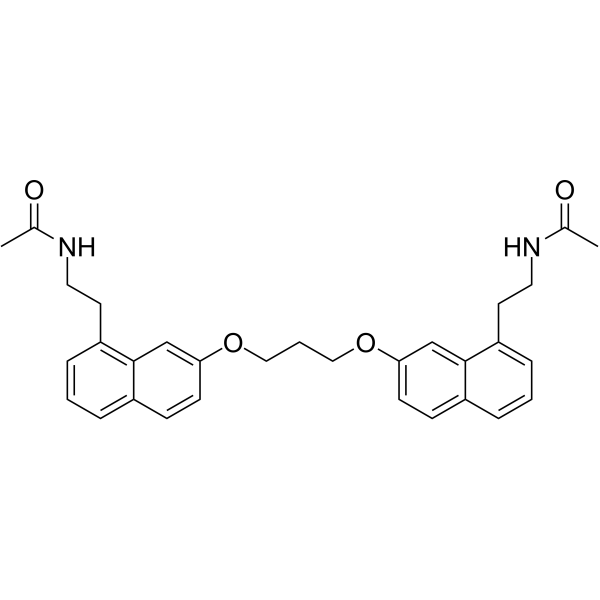
-
- HY-RS08743
-
|
|
Small Interfering RNA (siRNA)
|
Others
|
|
MT2A Human Pre-designed siRNA Set A contains three designed siRNAs for MT2A gene (Human), as well as a negative control, a positive control, and a FAM-labeled negative control.
|
-
MT2A Human Pre-designed siRNA Set A
MT2A Human Pre-designed siRNA Set A
-
- HY-107628
-
|
|
Melatonin Receptor
|
Neurological Disease
|
|
DH97 is a potent and selective antagonist of MT2 melatonin receptor, with a pKi of 8.03 for human MT2. DH97 shows 89- and 229-fold selectivity for human MT2 over human mt1 and Xenopus mel1c receptor subtypes. DH97 can inhibit melatonin-induced enhancement of electrically-evoked responses [2].
|
-

-
- HY-150079
-
|
|
HIV Integrase
|
Infection
|
|
HIV-1 integrase inhibitor 10 is an orally active HIV-1 allosteric integrase inhibitor (ALLINI). HIV-1 integrase inhibitor 10 can inhibit viral outgrowth of the NLRepRluc virus in MT-2 cells with EC50 values of 3-5 nM. HIV-1 integrase inhibitor 10 can be used for the research of Human immunodeficiency virus-1 (HIV-1) .
|
-
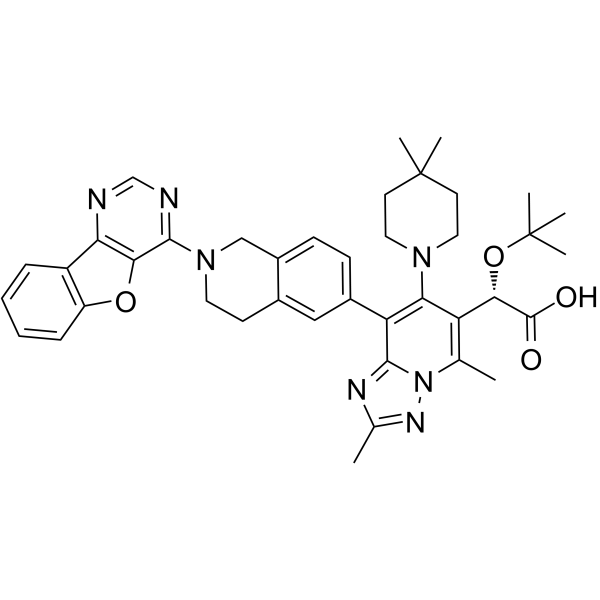
-
- HY-101254
-
Luzindole
Maximum Cited Publications
11 Publications Verification
N-0774
|
|
|
|
Luzindole (N-0774) is a selective melatonin receptor antagonist. Luzindole preferentially targets MT2 (Mel1b) over MT1 (Mel1a) with Ki values of 10.2 and 158 nM for human MT2 and MT1, respectively. Luzindole suppresses experimental autoimmune encephalomyelitis (EAE), and exerts antidepressant-like activity [2] .
|
-
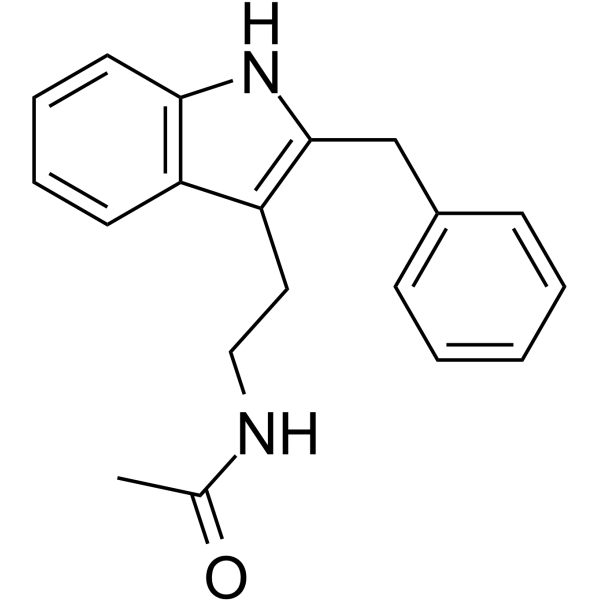
-
- HY-17038S
-
|
S-20098-d6
|
|
|
|
Agomelatine-d6 is deuterium labeled Agomelatine. Agomelatine is a specific agonist of MT1 and MT2 receptors[1] .
|
-

-
- HY-101074
-
|
2-Phenylmelatonin
|
|
|
|
UCM 608 is a high affinity melatonin (MT) membrane receptor agonist. The pKi values for MT1 and MT2 are 10.7 and 10.4 [2].
|
-
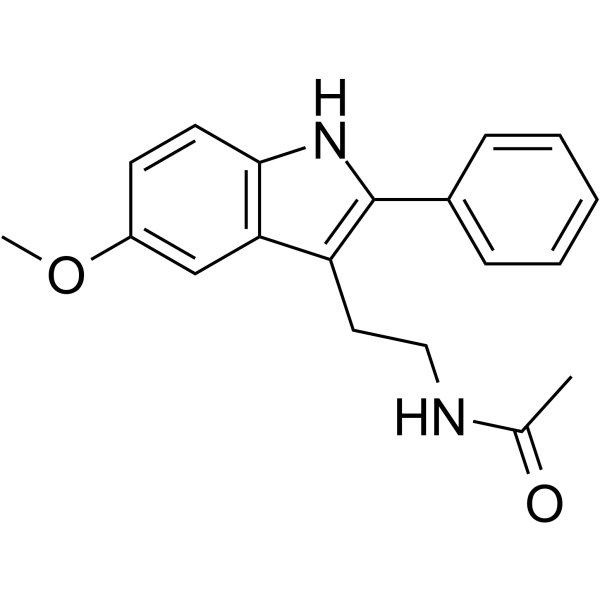
-
- HY-147542
-
-
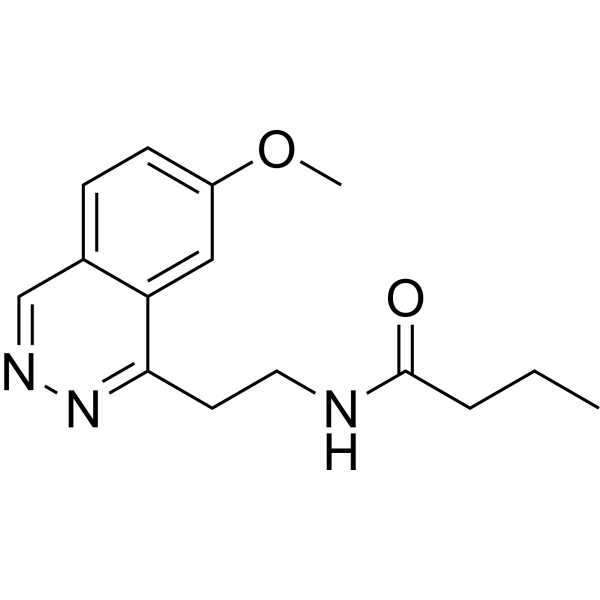
-
- HY-100609
-
|
|
Melatonin Receptor
|
Neurological Disease
|
|
4-P-PDOT is a potent, selective and affinity Melatonin receptor (MT2) antagonist. 4-P-PDOT is >300-fold more selective for MT2 than MT1. 4-P-PDOT significantly counteracts Melatonin-mediated antioxidant effects (GSH/GSSG ratio, phospho-ERK, Nrf2 nuclear translocation, Nrf2 DNA-binding activity) [2] .
|
-
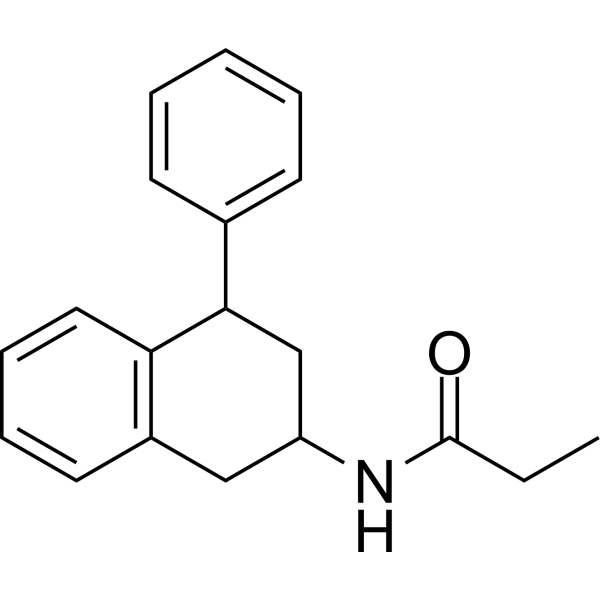
-
- HY-138626
-
|
|
Melatonin Receptor
|
Metabolic Disease
|
|
ACH-000143 is a potent and orally active melatonin receptor agonist, with EC50 values of 0.06 nM and 0.32 nM for MT1 and MT2, respectively .
|
-
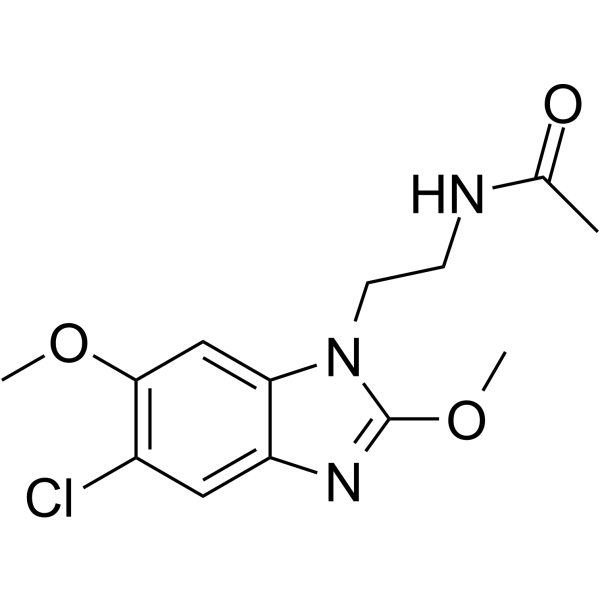
-
- HY-103005
-
-
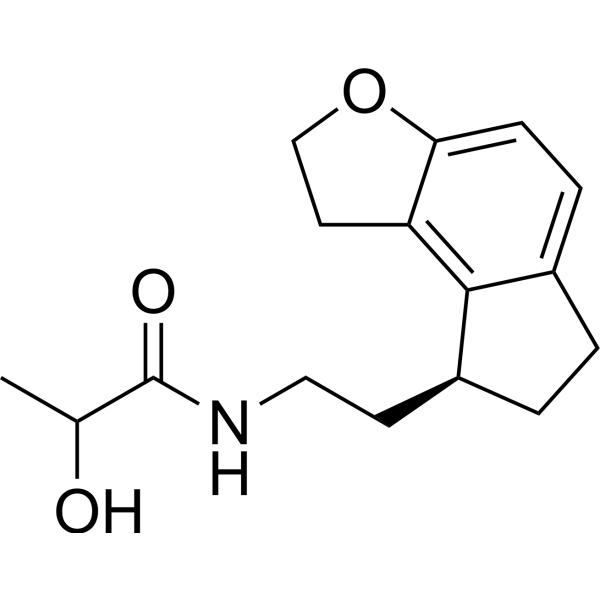
-
- HY-133113
-
|
|
5-HT Receptor
|
Neurological Disease
|
|
7-Desmethyl-agomelatine is a metabolite of Agomelatine. Agomelatineis a potent agonist at melatonin receptors (MT1 and MT2), and also is an antagonist of 5-HT2C [2].
|
-
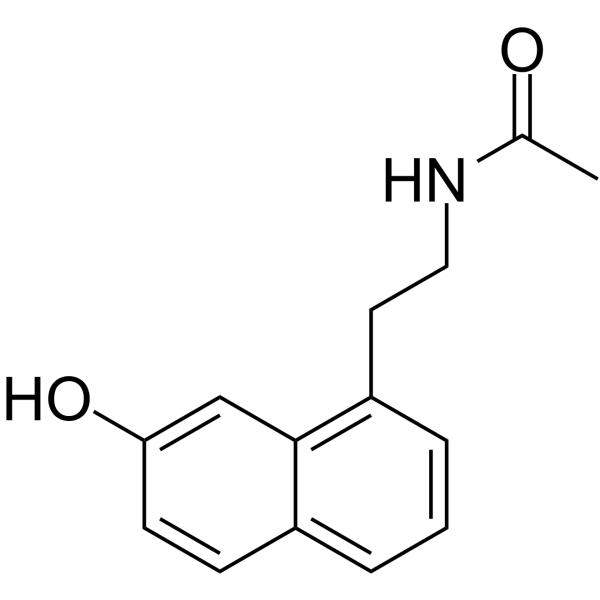
-
- HY-A0014
-
|
TAK-375
|
Melatonin Receptor
|
Neurological Disease
Endocrinology
Cancer
|
|
Ramelteon is a potent, highly selective, and orally active agonist of MT1/MT2 with Ki values of 14 and 112 pM, respectively. Ramelteon has the potential for the research of insomnia. Ramelteon consistently reduces sleep onset after long-term treatment, with no next-morning residual effects or rebound insomnia or withdrawal symptoms upon discontinuation [2].
|
-
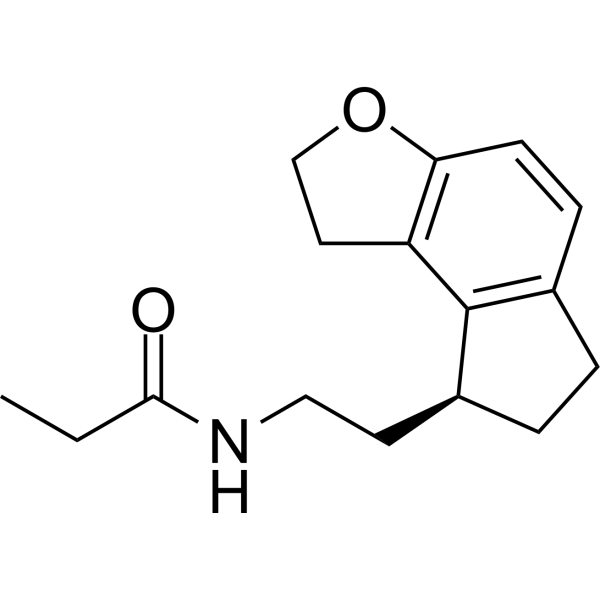
-
- HY-B0439S1
-
|
Sulphadoxine d3
|
Parasite
Antibiotic
|
Infection
|
|
Sulfadoxine-d3 is a deuterium labeled Sulfadoxine (HY-B0439). Sulfadoxine is a sulfonamide that is used, usually in combination with Pyrimethamine (HY-18062), for multidrug-resistant Plasmodium falciparum and P. vivax inhibition. Unlike PYR, Sulfadoxine has no impact on HIV replication or MT-2 cell cycle progression. But also Sulfadoxine exhibits suppression on respiratory, and urinary tract infections[1][2][3][4].
|
-

-
- HY-A0014S
-
|
TAK-375-d5
|
Isotope-Labeled Compounds
Melatonin Receptor
|
Neurological Disease
Endocrinology
Cancer
|
|
Ramelteon-d5 is deuterium labeled Ramelteon. Ramelteon is a potent, highly selective, and orally active agonist of MT1/MT2 with Ki values of 14 and 112 pM, respectively. Ramelteon has the potential for the research of insomnia. Ramelteon consistently reduces sleep onset after long-term treatment, with no next-morning residual effects or rebound insomnia or withdrawal symptoms upon discontinuation[1][2].
|
-
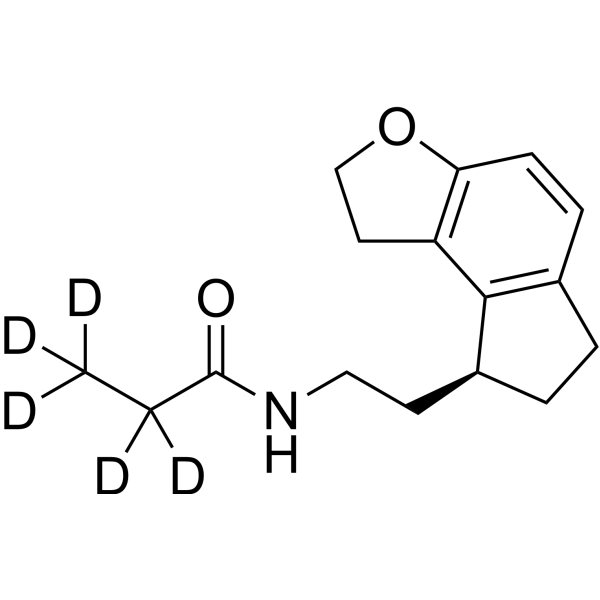
-
- HY-133112
-
|
3-Hydroxy-7-desmethyl agomelatine
|
Melatonin Receptor
5-HT Receptor
|
Neurological Disease
|
|
7-Desmethyl-3-hydroxyagomelatine (3-Hydroxy-7-desmethyl agomelatine), a metabolite of Agomelatine, has less activity than Agomelatine . Agomelatine is a melatonergic (MT1 and MT2) agonist and serotonergic (5HT2C) antagonist [2].
|
-

-
- HY-101176
-
|
|
Melatonin Receptor
|
Cancer
|
|
2-Iodomelatonin is a potent agonist of melatonin receptor 1 (MT1) with a Ki value of 28 pM, it is more 5-fold selective for MT1 over MT2 . 2-iodomelatonin can be used to identify, characterize and localize melatonin binding sites in the brain and peripheral tissues .
|
-
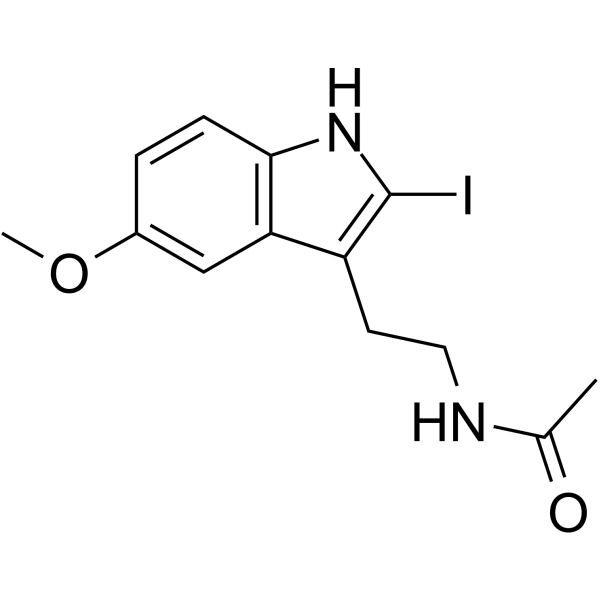
-
- HY-103005S
-
|
|
Melatonin Receptor
Drug Metabolite
|
Neurological Disease
Endocrinology
|
|
Ramelteon metabolite M-II-d3 is the deuterium labeled Ramelteon metabolite M-II. Ramelteon metabolite M-II is the major metabolite of Ramelteon, with IC50s of 208 pM, 1470 pM for human melatonin receptors (MT1 or MT2). Ramelteon is a selective melatonin agonist[1][2].
|
-

-
- HY-14803
-
|
BMS-214778; VEC-162
|
Melatonin Receptor
|
Neurological Disease
Endocrinology
|
|
Tasimelteon (BMS-214778) is an orally active and selective dual melatonin receptor agonist (DMRA). Tasimelteon has 2.1-4.4 times greater affinity for the MT2 receptor than for the MT1 receptor. Tasimelteon is a circadian regulator and has the potential for Non-24-Hour Sleep-Wake Disorder (Non-24) [2].
|
-
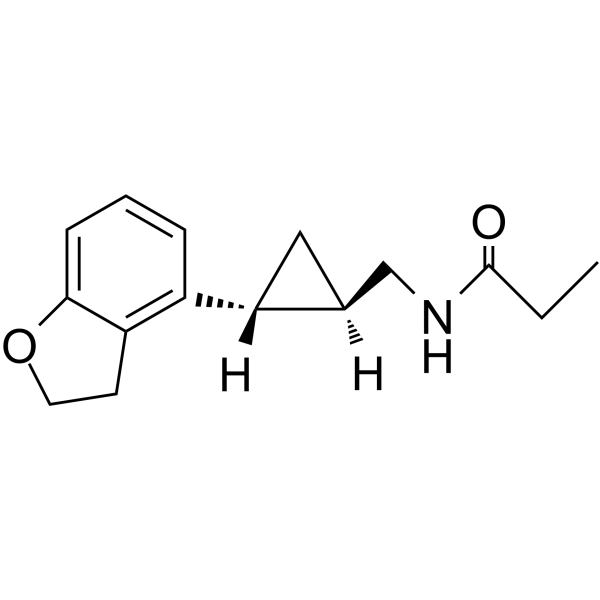
-
- HY-105285
-
|
Neu-P11
|
Melatonin Receptor
5-HT Receptor
P2X Receptor
TRP Channel
Sodium Channel
|
Neurological Disease
|
|
Piromelatine (Neu-P11) is a melatonin MT1/MT2 receptor agonist, serotonin 5-HT1A/5-HT1D agonist, and serotonin 5-HT2B antagonist. Piromelatine (Neu-P11) possesses sleep promoting, analgesic, anti-neurodegenerative, anxiolytic and antidepressant potentials. Piromelatine (Neu-P11) also possesses pain-related P2X3, TRPV1, and Nav1.7 channel-inhibition capacities [2] .
|
-
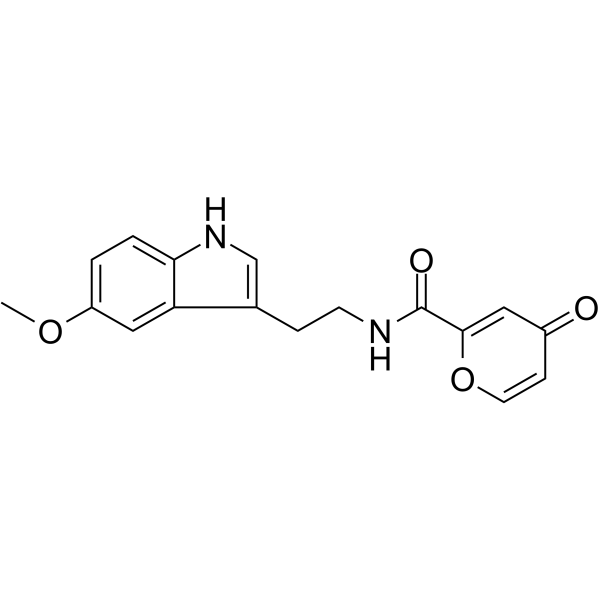
-
- HY-14803S
-
|
BMS-214778-d5; VEC-162-d5
|
Isotope-Labeled Compounds
Melatonin Receptor
|
Neurological Disease
Endocrinology
|
|
Tasimelteon-d5 is the deuterium labeled Tasimelteon. Tasimelteon (BMS-214778) is an orally active and selective dual melatonin receptor agonist (DMRA). Tasimelteon has 2.1-4.4 times greater affinity for the MT2 receptor than for the MT1 receptor. Tasimelteon is a circadian regulator and has the potential for Non-24-Hour Sleep-Wake Disorder (Non-24)[1][2].
|
-

-
- HY-100940
-
|
|
Melatonin Receptor
|
Endocrinology
|
|
6-Chloromelatonin is a potent melatonin receptor agonist with greater metabolic stability than melatonin. 6-Chloromelatonin compete for [ 3H]-melatonin and 2-[ 125I]-iodomelatonin binding to MT1 receptors (pKi=8.9 and 9.1, respectively). 6-Chloromelatonin compete for [ 3H]-melatonin binding to MT2 receptors (pKi=9.77) [2].
|
-
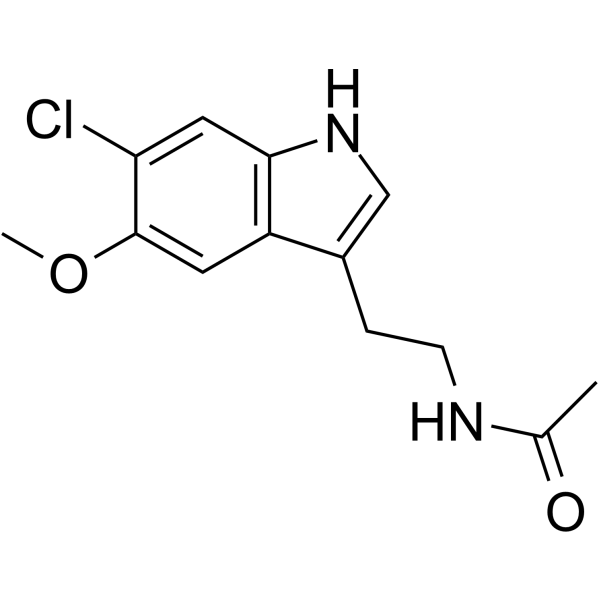
-
- HY-114962
-
|
|
Melatonin Receptor
|
Neurological Disease
|
|
S-22153 is a potent melatonin receptor antagonist with EC50 values of 19 nM, 4.6 nM for hMT1 and hMT2 melatonin receptor, respectively. S-22153 has Ki values of 8.6 nM (CHO cells) and 16.3 nM (HEK cells) for hMT1, and 6.0 nM (CHO cells) and 8.2 nM (HEK cells) for hMT2. S-22153 is a specific ligand of MT1 and MT2 melatonin receptors subtypes [2].
|
-
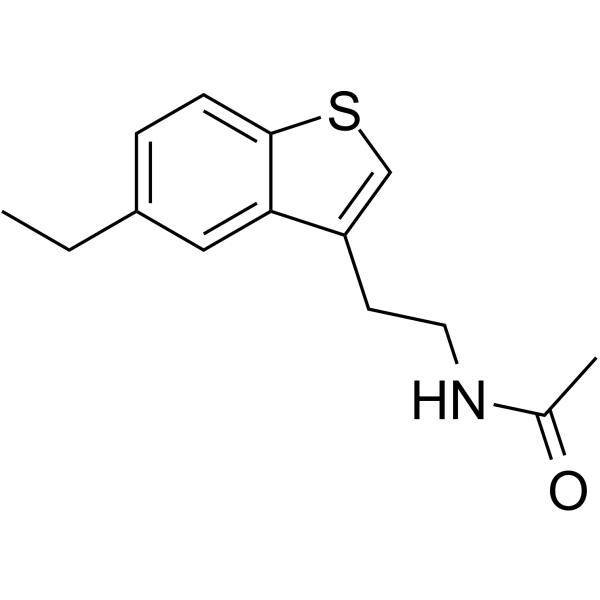
-
- HY-106136
-
|
PD-6735; LY-156735
|
Melatonin Receptor
5-HT Receptor
|
Neurological Disease
|
|
TIK-301 (PD-6735) is a chlorinated melatonin derivative and a potent, high-affinity and orally active melatonin MT1 and MT2 receptors agonist with Kis of 0.081 nM and 0.042 nM, respectively. TIK-301 is also a 5-HT2B/5-HT2C receptors antagonist with antidepressant action. TIK-301 has the potential for sleep disorders and other circadian rhythm disorders treatment [2] .
|
-
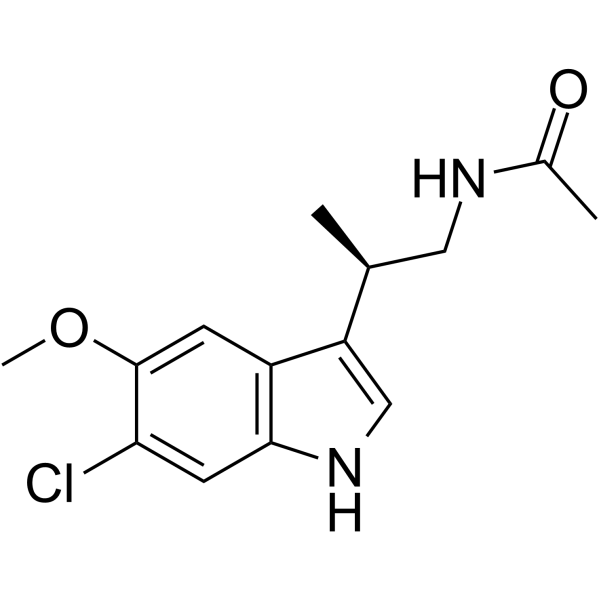
-
- HY-17038
-
|
S-20098
|
Melatonin Receptor
5-HT Receptor
Endogenous Metabolite
|
Neurological Disease
|
|
Agomelatine (S-20098) is a specific agonist of MT1 and MT2 receptors with Kis of 0.1, 0.06, 0.12, and 0.27 nM for CHO-hMT1, HEK-hMT1, CHO-hMT2, and HEK-hMT2, respectively . Agomelatine is a selective 5-HT2C receptor antagonist with pKis of 6.4 and 6.2 at native (porcine) and cloned, human 5-HT2C receptors, respectively [2].
|
-

-
- HY-17038A
-
|
S-20098 hydrochloride
|
Melatonin Receptor
5-HT Receptor
Endogenous Metabolite
|
Neurological Disease
|
|
Agomelatine hydrochloride (S-20098 hydrochloride) is a specific agonist of MT1 and MT2 receptors with Kis of 0.1, 0.06, 0.12, and 0.27 nM for CHO-hMT1, HEK-hMT1, CHO-hMT2, and HEK-hMT2, respectively . Agomelatine hydrochloride is a selective 5-HT2C receptor antagonist with pKis of 6.4 and 6.2 at native (porcine) and cloned, human 5-HT2C receptors, respectively [2].
|
-
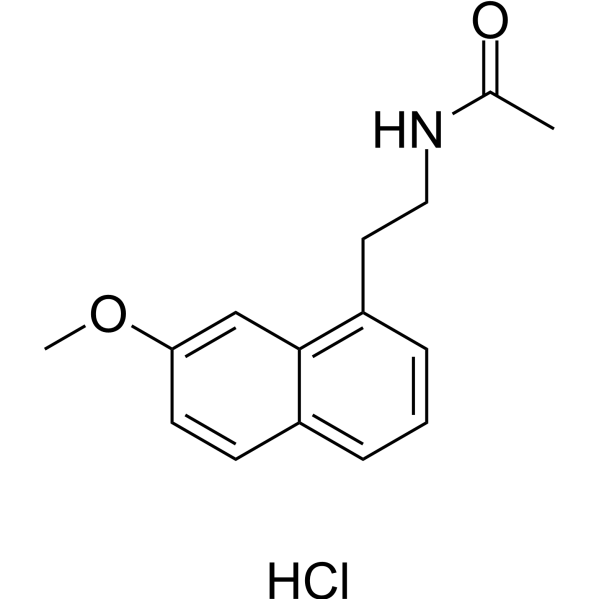
-
- HY-17038B
-
|
S-20098 L(+)-Tartaric acid
|
Melatonin Receptor
5-HT Receptor
Endogenous Metabolite
|
Neurological Disease
|
|
Agomelatine L(+)-Tartaric acid (S-20098 L(+)-Tartaric acid) is a specific agonist of MT1 and MT2 receptors with Kis of 0.1, 0.06, 0.12, and 0.27 nM for CHO-hMT1, HEK-hMT1, CHO-hMT2, and HEK-hMT2, respectively . Agomelatine L(+)-Tartaric acid is a selective 5-HT2C receptor antagonist with pKis of 6.4 and 6.2 at native (porcine) and cloned, human 5-HT2C receptors, respectively [2].
|
-
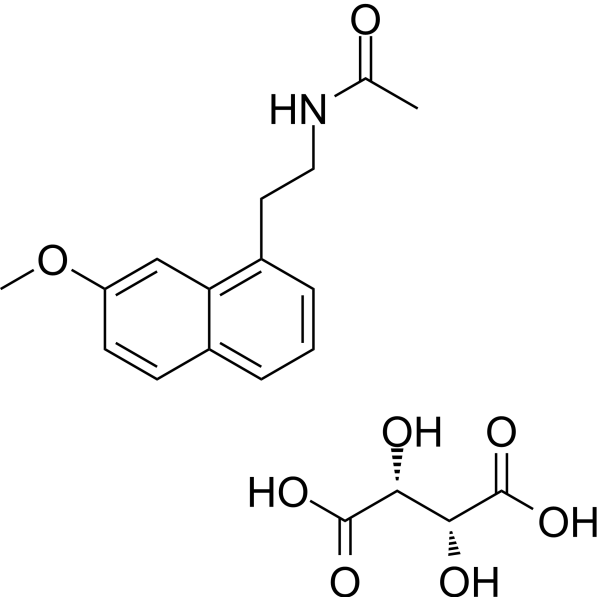
-
- HY-17038S1
-
|
S-20098-d4
|
Isotope-Labeled Compounds
Melatonin Receptor
5-HT Receptor
Endogenous Metabolite
|
Neurological Disease
|
|
Agomelatine-d4 is the deuterium labeled Agomelatine. Agomelatine (S-20098) is a specific agonist of MT1 and MT2 receptors with Kis of 0.1, 0.06, 0.12, and 0.27 nM for CHO-hMT1, HEK-hMT1, CHO-hMT2, and HEK-hMT2, respectively[1]. Agomelatine is a selective 5-HT2C receptor antagonist with pKis of 6.4 and 6.2 at native (porcine) and cloned, human 5-HT2C receptors, respectively[2].
|
-

-
- HY-17038S2
-
|
S-20098-d3
|
Melatonin Receptor
5-HT Receptor
Endogenous Metabolite
|
Neurological Disease
|
|
Agomelatin-d3 is the deuterium labeled Agomelatine. Agomelatine (S-20098) is a specific agonist of MT1 and MT2 receptors with Kis of 0.1, 0.06, 0.12, and 0.27 nM for CHO-hMT1, HEK-hMT1, CHO-hMT2, and HEK-hMT2, respectively[1]. Agomelatine is a selective 5-HT2C receptor antagonist with pKis of 6.4 and 6.2 at native (porcine) and cloned, human 5-HT2C receptors, respectively[2].
|
-

-
- HY-139985
-
|
|
HIV
|
Infection
|
|
NBD-14189 is a potent HIV-1 entry antagonist with an IC50 of 89 nM against the HIV-1HXB2 pseudovirus. NBD-14189 binds to HIV-1 gp120 and shows potent antiviral activity (EC50<200 nM) [2].
|
-

-
- HY-17605A
-
|
GS-9883 sodium
|
HIV Integrase
HIV
|
Infection
|
|
Bictegravir sodium is a potent inhibitor of HIV-1 integrase, with an IC50 of 7.5 nM. Bictegravir sodium exhibits potent and selective anti-HIV activity and low cytotoxicity .
|
-
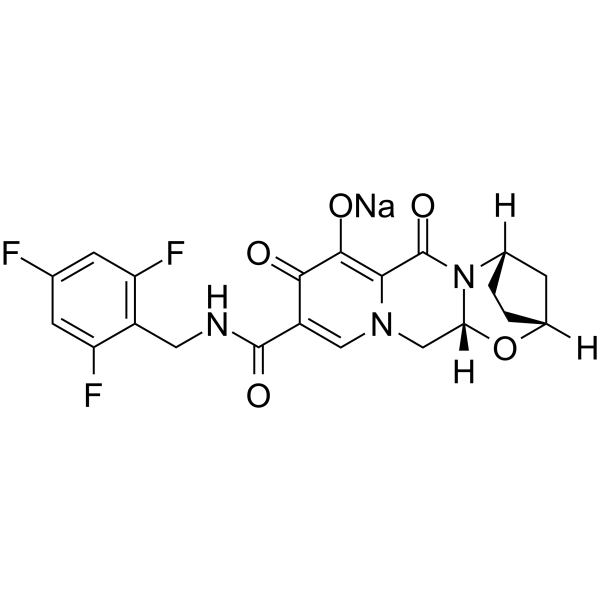
-
- HY-120075
-
|
|
Apoptosis
|
Cancer
|
|
TJ191 is a potent and specific anti-cancer agent that targets low TβRIII-expressing malignant T-cell leukemia/lymphoma cells. TJ191 has no affects on the proliferation of other cancer cells or normal fibroblasts or immune cells. TJ191 can be used for cancer research .
|
-
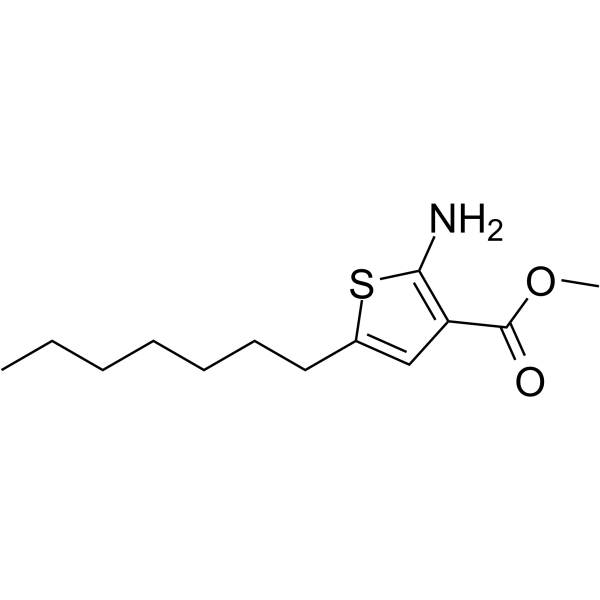
| Cat. No. |
Product Name |
Category |
Target |
Chemical Structure |
| Cat. No. |
Product Name |
Chemical Structure |
-
- HY-B0439S1
-
|
|
|
Sulfadoxine-d3 is a deuterium labeled Sulfadoxine (HY-B0439). Sulfadoxine is a sulfonamide that is used, usually in combination with Pyrimethamine (HY-18062), for multidrug-resistant Plasmodium falciparum and P. vivax inhibition. Unlike PYR, Sulfadoxine has no impact on HIV replication or MT-2 cell cycle progression. But also Sulfadoxine exhibits suppression on respiratory, and urinary tract infections[1][2][3][4].
|
-

-
- HY-103005S
-
|
|
|
Ramelteon metabolite M-II-d3 is the deuterium labeled Ramelteon metabolite M-II. Ramelteon metabolite M-II is the major metabolite of Ramelteon, with IC50s of 208 pM, 1470 pM for human melatonin receptors (MT1 or MT2). Ramelteon is a selective melatonin agonist[1][2].
|
-

-
- HY-A0014S
-
|
|
|
Ramelteon-d5 is deuterium labeled Ramelteon. Ramelteon is a potent, highly selective, and orally active agonist of MT1/MT2 with Ki values of 14 and 112 pM, respectively. Ramelteon has the potential for the research of insomnia. Ramelteon consistently reduces sleep onset after long-term treatment, with no next-morning residual effects or rebound insomnia or withdrawal symptoms upon discontinuation[1][2].
|
-

-
- HY-14803S
-
|
|
|
Tasimelteon-d5 is the deuterium labeled Tasimelteon. Tasimelteon (BMS-214778) is an orally active and selective dual melatonin receptor agonist (DMRA). Tasimelteon has 2.1-4.4 times greater affinity for the MT2 receptor than for the MT1 receptor. Tasimelteon is a circadian regulator and has the potential for Non-24-Hour Sleep-Wake Disorder (Non-24)[1][2].
|
-

-
- HY-17038S1
-
|
|
|
Agomelatine-d4 is the deuterium labeled Agomelatine. Agomelatine (S-20098) is a specific agonist of MT1 and MT2 receptors with Kis of 0.1, 0.06, 0.12, and 0.27 nM for CHO-hMT1, HEK-hMT1, CHO-hMT2, and HEK-hMT2, respectively[1]. Agomelatine is a selective 5-HT2C receptor antagonist with pKis of 6.4 and 6.2 at native (porcine) and cloned, human 5-HT2C receptors, respectively[2].
|
-

-
- HY-17038S2
-
|
|
|
Agomelatin-d3 is the deuterium labeled Agomelatine. Agomelatine (S-20098) is a specific agonist of MT1 and MT2 receptors with Kis of 0.1, 0.06, 0.12, and 0.27 nM for CHO-hMT1, HEK-hMT1, CHO-hMT2, and HEK-hMT2, respectively[1]. Agomelatine is a selective 5-HT2C receptor antagonist with pKis of 6.4 and 6.2 at native (porcine) and cloned, human 5-HT2C receptors, respectively[2].
|
-

| Cat. No. |
Product Name |
Application |
Reactivity |
-
- HY-P81151
-
|
MT2; melatonin receptor type 1B; melatonin receptor; MEL1B; MEL-1B-R; MTnr1b; MGC129286; MGC129287; MTNR-1B; Melatonin receptor 1B; MTR1B_HUMAN.
|
WB; ELISA; IHC-P; IHC-F; IF
|
Human, Mouse, Rat(predicted: Dog) |
|
MTNR1B Antibody is an unconjugated, approximately 40 kDa, rabbit-derived, anti-MTNR1B polyclonal antibody. MTNR1B Antibody can be used for: WB, ELISA, IHC-P, IHC-F, IF expriments in human, mouse, rat, and predicted: dog background without labeling.
|
Your information is safe with us. * Required Fields.
Inquiry Information
- Product Name:
- Cat. No.:
- Quantity:
- MCE Japan Authorized Agent:








































